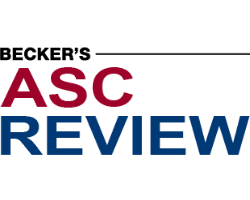Study: Ergonomic guidelines needed for trainees assisting in minimally invasive procedures

Editor's Note A prospective cohort study among general surgery residents in Singapore highlighted the need for ergonomic improvements and education for surgical trainees during minimally invasive abdominal surgery. Published May 31 in Scientific Reports, the study was limited by a small sample size and variability in respondent characteristics and practices.…
Study: Surgeon video consults up since pandemic, but challenges remain

Editor's Note Need for physical examination, technological limitations, care quality concerns, and malpractice risk topped the list of perceived barriers to employing video visits in surgical care in a study published May 10 in the journal Surgery. This study was reportedly the first to comprehensively survey surgeons on their perception…
Industry leaders share main growth opportunities for ASCs

Editor's Note Following are various growth opportunities for ambulatory surgery centers (ASCs), as identified by four industry leaders and published by Becker’s ASC Review on May 10: Sean Hartzell, principal of ECG Management Consultants, identified: Growth potential in shifting low- to medium-acuity and single-night stay cases from hospitals to ASCs…
Wearables could help surgeons maintain healthy posture during lengthy procedures

Editor's Note Wearable technology is a useful means of mitigating the risk of musculoskeletal disorders in surgeons by providing biofeedback on posture during lengthy operations, according to a recent study in Journal of Nuerosurgery: Spine. In an April 22 report, AZO Sensors details how researchers from Baylor College of Medicine collaborated with…
Shutting down of ASC prompts $500M lawsuit from spine surgeon against state of Florida

Editor's Note The Bonati Spine Institute, based in Hudson, Florida, filed a $500 million lawsuit in federal court against the state of Florida, Business Observer April 4 reports. The lawsuit accuses the Florida Agency for Health Care Administration (AHCA) of wrongful shutdown, civil rights violations, conspiracy, defamation, and libel. This…
Brain monitoring helps understand, combat cognitive overload in surgeons

Editor's Note Researchers at Imperial College London are using noninvasive brain monitoring to understand the stressors contributing to cognitive overload in surgeons as well as how to combat the condition. The Guardian reported the news on March 2. The monitoring technique, called functional near-infrared spectroscopy (fNIRS), measures neural activity in…
Surgeons, anesthesiology rank high on “stressful job” list

Editor's Note Citing research from Dolman Law Group, a March 11 article in Becker’s ASC Review notes that surgeons have the second-most stressful job of any profession in the US. Anesthesiology was third most stressful, while paramedic was fourth. Steelworker topped the list. The Dolman Law Group research examined data…
Study: Perioperative nurses experience high rates of “disruptive” behavior

Editor's Note: Healthcare institutions urgently need intervention strategies to reduce disruptive behavior toward perioperative nurses, according to a report published in the Journal of PeriAnesthesia Nursing on January 9. The recommendation follows a cross-sectional survey designed to “investigate the prevalence, characteristics, causes, consequences, and predictors of and responses to disruptive…
Scrub color affects how patients perceive clinicians

Editor's Note: A recent study shows the color of a clinicians’ scrubs is a factor in how patients view clinicians and, by extension, the clinician-patient relationship as well as clinical outcomes. The findings were published January 11 in Jama Surgery. Although previous research has established connections between physician’s attire and…
Maximizing surgical excellence: Strategies for attracting top surgeons

A 2021 report by the Association of American Medical Colleges projects shortages of 15,800 to 30,200 in all surgical specialties by 2034. Driven by various factors, including the growing healthcare needs of an aging population, an aging surgical workforce—with many surgeons and nurses nearing retirement—and limited capacity in medical and…

 Free Daily News
Free Daily News